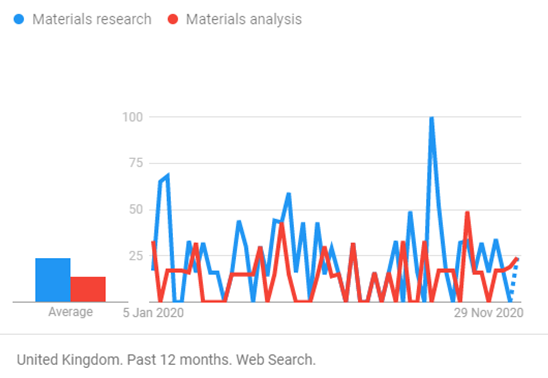SEO and Google Trends
One of the most important tools for developing an SEO strategy is Google Trends. Google collects many different types of data arising from the use of its search engine. And Google Trends is the most fundamental of these. Google Trends lists how many times a search engine term has been used across countries by time.
When thinking about what products and services you sell the first fundamental question is, what search term will people use to look for the services that I offer ? Often, the answer to this question is more difficult than you would think.
For many years, I have worked in materials research. Logically the most obvious research term to optimise a website in that area is of course the string “Materials Research”. However, if you wish to generate income other terms might also be important. An alternative term to generate consultancy “Materials Analysis”. Use of Google Trends reveals that the term Materials Research is used more often than the term materials analysis. However when an analysis of the company’s exploiting those terms takesk place it becomes immediately obvious that the term Materials Research is dominated by very large universities with huge research departments, whereas the term materials analysis was occupied more by companies offering an analytical service to industry. So for the generation of income it could be useful to optimise the website for “Materials analysis” because there was a good number of searches and also a reasonable chance of occupying a postion on the front page of Google.

Targeting the right term
Everyone’s ideal is to be on Page one of Google for the search term of their choice. But it’s not that easy. So if I was a paint company specialising in refinishing paint for classic cars I would have to think very hard. Of course, being on page one for the search term “paint” is extremely hard. This area is dominated by large companies with huge marketing budgets. If I was trying to optimise for the search term “Refinishing paint” I would encounter similar problems but on a more manageable scale. There were many Paint refinishing companies out there selling their products and reaching page one would be more still be difficult. If I went the longer term search term “Refinishing paint for classic cars”, there is a possibility of making page one or even position one of page 1 for that term. But then I would have the task of optimising the pages of the website for that much longer term.
Optimising for "Long tail" searches
In the above example the term “Refinishing paint for classic cars” is itself a typical long tailed search term.
Optimising a website for a long tailed search term can be tricky, because there is a large temptation to litter web pages with that exact term in many different places. Over the years, the Google search engine crawler has become wise to such tricks, and it is likely to penalise you for using the term out of context simply in order to be able to rank more highly in Google.
The best technique is to split up the long tail search term into its component parts, and to make sure that your website would show the benefits of your product for the different components of the term. For instance, in this example, the company would be well advised to have separate pages about refinishing paint, classic car maintenance, and them move on to their own product, and the benefits of their product for the marketplace. Only then, would the Google search crawler identify the site as being ideal for that search term.